Four popular Malaysian recipes to make at home
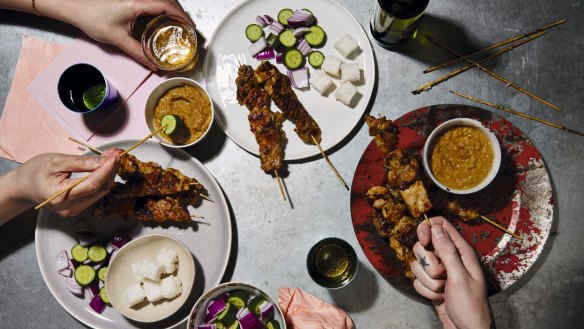
Mandy Yin, who runs London's Sambal Shiok Laksa Bar, says her goal in life is to encourage more people to appreciate the joys of Malaysian food.
While spicy, pungent, no-holds-barred flavours are her calling card, not all the dishes in her first cookbook set the spice dial to 11. The book gathers together more than 90 recipes, ranging from snacks and salads to curries and sweets.
And while not all of her recipes are strictly traditional, they are firmly rooted in Malaysian flavours. These dishes are some of the most popular on her menu and across Malaysia.
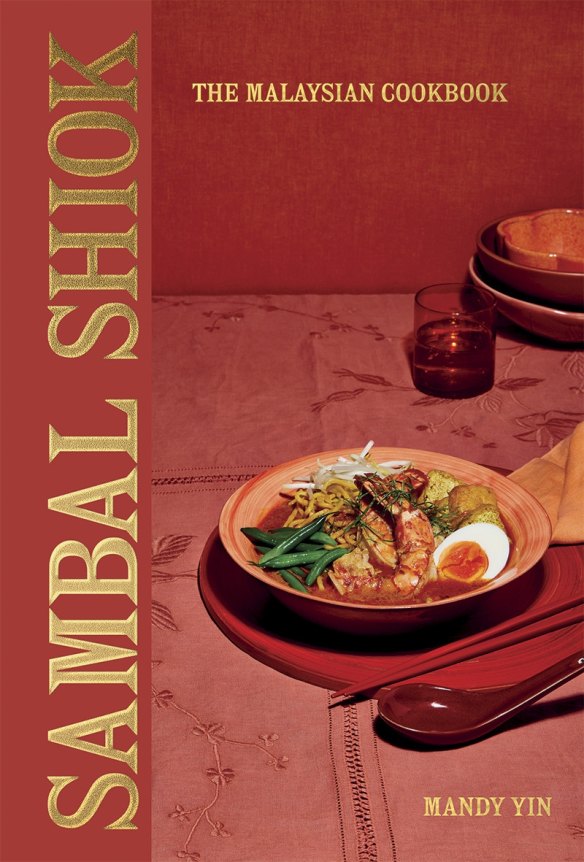
Chicken satay
Skewers of chicken satay are a perennial crowd pleaser, and perfect for any summer barbecue. Of course, they can also be grilled indoors, but there is nothing better than satay cooked outdoors over smoky flames! This recipe needs to be started at least five hours in advance or the night before to allow for marinating time. Please, please, please use thigh meat for this dish. Breast meat would simply dry out if cooked this way.
You will end up with roughly double the amount of satay spice paste for the amount of chicken required for this recipe. The paste keeps very well for up to a month in the fridge and can also be frozen for up to a year. My peanut sauce is runnier than the traditional sauce served with satay because it was originally meant to provide moisture for the chicken satay burger at my street-food stall.
INGREDIENTS
- 1 lemongrass stalk, roughly chopped
- 600g onion, roughly chopped
- 5 garlic cloves
- 1 tsp ground coriander
- 1 tsp chilli powder
- 1 tsp ground turmeric
- ½ tsp fennel seeds
- ½ tsp ground cumin
- 1 tbsp salt
- 100g dark brown sugar
- 180g lightly salted peanuts, dry-toasted
- 75g satay spice paste (see recipe)
- 200ml (scant 1 cup) coconut milk
- 60g dark brown sugar
- 2½ tbsp tamarind paste
- ¼ tsp chilli powder
- 150ml (scant ⅔ cup) water
- ½ tsp salt (or to taste)
Chicken skewers
- 1kg skinless and boneless chicken thighs, sliced into 2cm-wide strips with those strips then cut into 2.5cm-long pieces
- 20 bamboo skewers, soaked in cold water for 10 minutes
- 3 tbsp oil
- 1 cucumber and 150g red onion, roughly chopped, to serve
METHOD
- To make the satay spice paste, blend all the ingredients to a fine puree. If using a smaller food processor or handheld stick blender, you will have to work in batches, combining the batches once they're ready. Always mix lemongrass with some onion to provide easier fodder for the blender's blades (blitzing lemongrass by itself can be very hard work and you will be left with undesirable hard, fibrous strands).
- To make the peanut sauce, grind the peanuts using the pulse function of a food processor until you get a rough, sandy texture. Add the ground peanuts, along with the rest of the sauce ingredients, to a medium-sized saucepan. Set over a medium heat and bring to the boil, stirring frequently to prevent the sauce at the bottom of the pan from burning. Reduce the heat to low and simmer for 5 minutes until the sauce thickens.
- To make the chicken skewers, marinate the chicken pieces with 150g satay spice paste and refrigerate for at least 4 hours or preferably overnight. Once marinated, skewer the chicken so that there are five or six pieces per skewer. Drizzle the oil over the chicken skewers.
- Grill the chicken on a high heat for 5 minutes, turning frequently to char all sides. You can also use a griddle pan or a barbecue. If cooking indoors, make sure to open all the windows as the charring produces quite a lot of smoke (the smokiness is key to good satay). Serve with peanut sauce, cucumber and red onion.
Serves 6-10
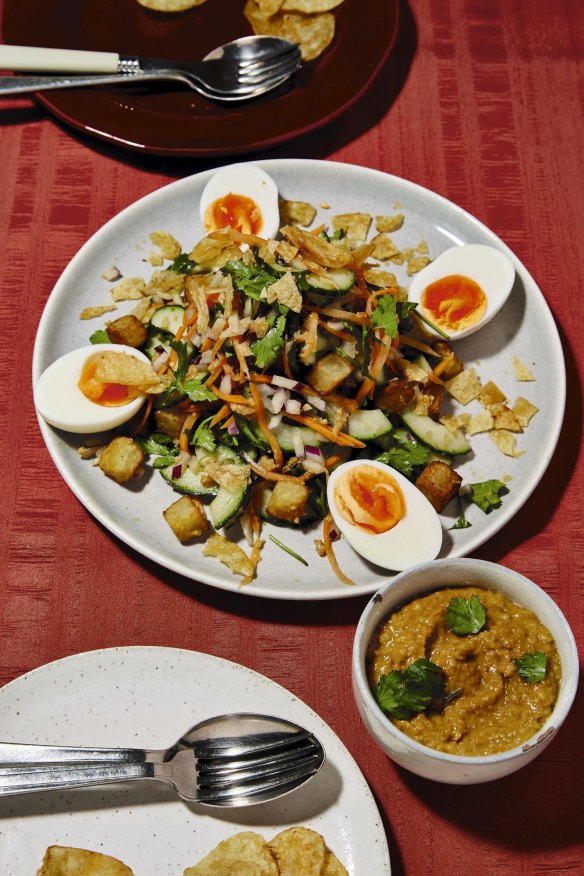
Peanut gado gado salad
This is the secret sleeper on the restaurant's menu and hasn't changed since we opened. It is very unassuming and many overlook it for the sexier Malaysian fried chicken on our snacks section. However, once you've tried this salad, full of different textures and crunch, you will be hooked.
You only need two tablespoons' worth of the pickled carrot for this recipe, drained from its pickling liquid. It keeps very well for up to a month in the fridge so you can happily add it to other salads, stir-fries or sandwiches for a kick of flavour.
INGREDIENTS
- 60ml (¼ cup) white rice vinegar
- 60g white sugar
- 200g carrot, sliced into fine matchsticks
- 30g red onion, finely chopped
- ½ cucumber
- 100g potato, cut into 1cm cubes
- 3 tbsp oil
- small handful of coriander leaves
- 200g peanut sauce (see recipe)
- 2 eggs, hard-boiled for 7½ minutes, peeled and cut into quarters lengthways
- handful of lightly salted cassava, or potato chips
METHOD
- First, make a simple pickle. Warm the vinegar and sugar in a small saucepan, just enough to melt the sugar. Pour over the julienned carrot and leave for at least an hour.
- Next, prepare the other vegetables. Soak the chopped red onion in cold water for at least 15 minutes, then drain. Cut the cucumber in half lengthways and use a spoon to deseed. Finely slice so that you end up with crescent moon shapes, ideally no thicker than 5mm.
- Parboil the potato cubes for 3 minutes before draining and leaving to cool. Once cool, pan-fry in 3 tablespoons of oil over a medium-high heat until crispy.
- Place 2 tablespoons of the carrot pickle, red onion, cucumber and fried potatoes, along with the coriander leaves and peanut sauce, into a mixing bowl. Mix well to combine before transferring to a serving plate.
- Place the egg quarters on the plate around the salad. Gently crush the crisps with your hands and sprinkle over the salad. Eat immediately, as the vegetables will go soggy if left in the sauce for too long.
Serves 2 as a snack, or 1 for lunch
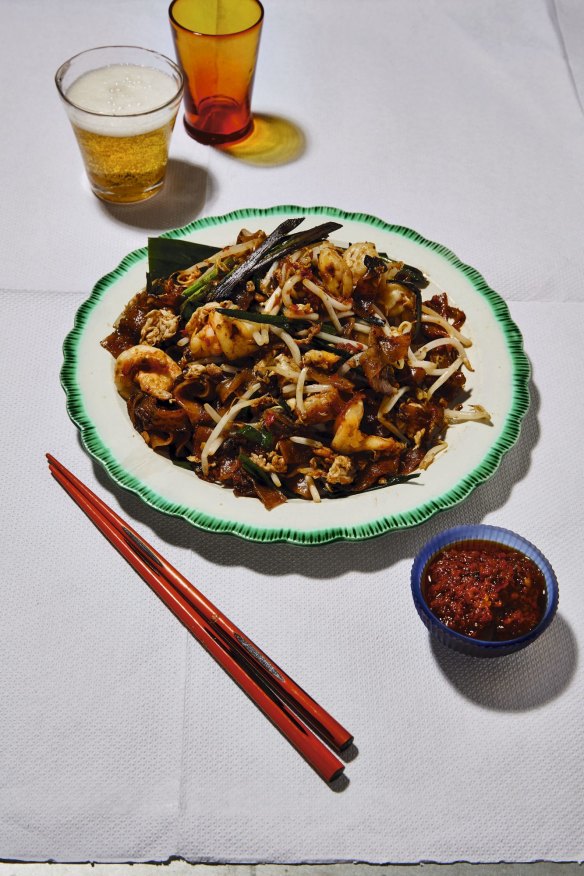
Char kwai teow (fried flat rice noodles)
You will find the best char kwai teow in Penang sold by hawkers behind their woks atop hellishly hot flames, usually made stronger by a large industrial fan and a powerful extractor hood above them. It is quite difficult to replicate the wok hei, or the breath of the wok, on domestic stovetops as it is impossible to get the heat intensity required. I find this method of frying one portion at a time results in a decent version of the dish.
You can substitute the prawns with slices of fishcakes, squid rings or chicken breast. To make this recipe vegan, use finely sliced fried firm tofu or tofu puffs and simply leave out the egg.
INGREDIENTS
- 80g dried Thai flat rice sticks or 200g fresh ho fun flat wide rice noodles
- 2 tbsp oil
- 3 stalks of Chinese chives, sliced into 5cm-long batons, or substitute with 2 spring onions
- 2 garlic cloves, finely chopped
- 80g prawns, cut carefully in half lengthways through the body so that you end up with two prawn semi-circles (this will result in springy, tender prawns)
- 1 egg
- handful of beansprouts
- 1 tbsp simple chilli sauce (see recipe)
Seasoning
- 1 tbsp kecap manis sweet soy sauce (if you don't have this, double the quantity of light soy sauce and increase the dark brown sugar to ½ tsp)
- 1 tbsp light soy sauce
- ¼ tsp salt
- ⅛ tsp ground white pepper
- ¼ tsp dark brown sugar
- 60g dried chilli flakes
- 2 tbsp dark brown sugar
- ½ tsp salt
- 420ml (1¾ cups) water
METHOD
- To make the simple chilli sauce, add all the ingredients to a medium saucepan and bring to the boil. Switch off the heat and leave for 1 hour. Bring to the boil again and simmer over a medium heat for 15 minutes. Turn off the heat and use a hand blender to blend into a sauce.
- To prepare the noodles, follow the instructions on the packet of dried rice sticks. Drain through a fine strainer and run cold water over them to cool thoroughly (don't miss this step or the noodles will continue cooking and then clump up in your wok later). If using fresh ho fun rice noodles, loosen the noodles so that they are in individual strands rather than one lump. Microwaving fresh ho fun, straight after you've taken them out of the packet, for 30-60 seconds (60 seconds if they are fridge-cold) loosens them perfectly.
- Mix the seasoning in a bowl so it's ready to throw into the wok later in one fell swoop.
- Place a wok over a high heat until it is smoking. To achieve any sort of wok hei, you MUST fry only one portion at a time. Add the oil, garlic and half of the Chinese chives. Stir-fry for a few seconds until the chives have charred a bit.
- Add the noodles and seasoning. Stir-fry for several minutes until the noodles are charred and have picked up some smokiness from the wok.
- Now add the prawns and stir-fry for 1 minute.
- Make space towards the side of the wok, crack in an egg, stir to mix and cook for a few seconds.
- Finally, add the beansprouts along with the remainder of the Chinese chives and the simple chilli sauce. Stir-fry for 30 seconds and serve hot.
Serves 1
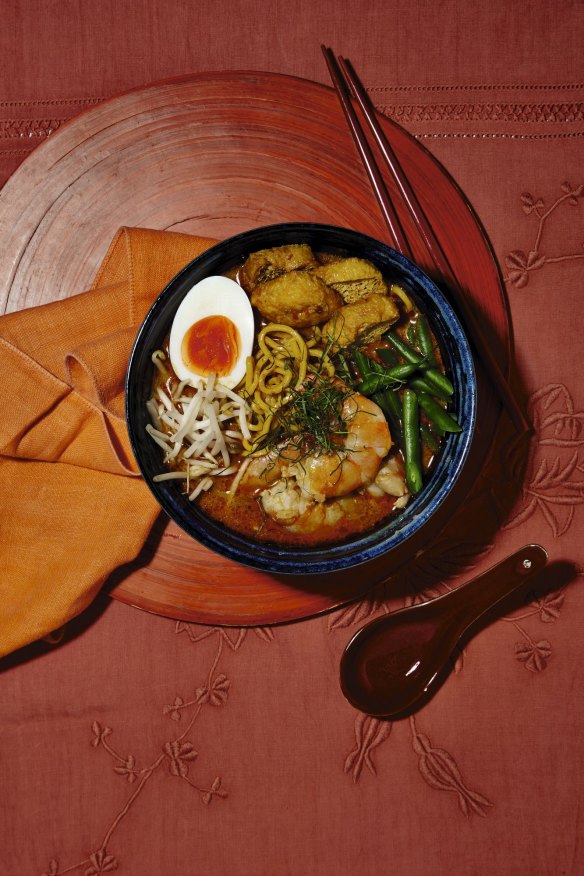
Signature curry laksa
This is my signature curry laksa, with a strong chilli and prawn kick, served at the restaurant. Most of the preparation can be done a day or two in advance, like cooking the chicken stock, blitzing and cooking the spice paste, prawns (and eggs, and blanching the beansprouts and green beans. The noodles are best blanched just before serving. If you can find them, laksa leaves (ask for rau ram or hot mint in Vietnamese supermarkets) add a distinctive fragrance.
At the restaurant we substitute shrimp paste with a touch of white shiro miso paste and tomato paste to make the broth vegan. If you would like to make the vegan version, replace the shrimp paste with 1 tablespoon of miso paste and 1 tablespoon of tomato puree, and use vegetable instead of chicken stock. Go wild with your imagination in terms of vegan toppings – at the restaurant we char thin slices of eggplant and small florets of broccoli in the oven before lightly salting them.
I recommend starting this recipe a day before you want to eat it to give the fried-off laksa paste a chance to fully mature overnight, and also especially if making your own chicken stock.
INGREDIENTS
Spice paste
- 150ml (scant ⅔ cup) oil
- 300g onion, roughly chopped
- 8cm ginger, roughly chopped
- 8 garlic cloves
- 3 red chillies, roughly chopped
- 15 dried chillies, soaked in hot water for 30 minutes before using and then drained
- 1½ tbsp ground cumin
- 1½ tbsp ground turmeric
- 3 tbsp ground coriander
- 3 tbsp chilli powder
- 25g shrimp paste
Laksa broth
- 1.7 litres chicken stock
- 800ml (3½ cups) coconut milk
- 70g good-quality caramelised palm sugar or dark brown sugar
- 2 tbsp salt (or to taste)
- 3 tbsp tamarind paste
- 50g bunch of laksa leaves, or mint or coriander as a substitute
- 2 lemongrass stalks, cut in half then pounded lightly with a pestle to bruise
Assembling the bowls
- 6 eggs
- 12 deep-fried tofu puffs, cut into half
- 120g green beans, cut into 5cm lengths
- 200g beansprouts
- 24 king prawns, deshelled and deveined
- 600g fresh egg noodles
- handful of laksa leaves, or mint or coriander leaves, finely sliced, to garnish
METHOD
- To make the spice paste, blend all of the spice paste ingredients to a fine puree. In a large non-stick frying pan over a medium-low heat, cook the spice paste, continuously stirring for 20 minutes, until it is a rich, dark red-brown colour and the oil separates from the paste. Ideally leave for at least 24 hours in the fridge for the fried paste to develop maximum flavour before using it to make the broth.
- To make the laksa broth, add the laksa broth ingredients to a large saucepan along with the fried spice paste. Bring to the boil, then simmer gently on the lowest heat for 20 minutes. Turn off the heat, then remove the laksa leaves/mint/coriander and lemongrass, and adjust the seasoning (the salt and sugar), to taste. Add the tofu puffs to the broth for 10 minutes so that they soak up the flavour.
- Assembling the bowls. I have often been asked how to boil a soft-boiled egg like we do at the restaurant. We use medium-sized eggs at room temperature. Start by bringing 8cm of water up to boil in a saucepan. Lower the eggs into the water with a slotted spoon and turn down the heat so it is at a rolling boil. Set a timer for 6½ minutes for soft-boiled or 7½ minutes for hard-boiled. Once the time is up, immediately take the eggs out, put in a deep bowl of cold water and leave them for 2 minutes to stop the cooking. It is easiest to peel the eggs in water as the water helps to get between the egg's membrane and the shell. Slice in half.
- Fill another saucepan with water and bring to the boil. While the laksa broth is simmering, blanch the following in boiling water one after the other: beansprouts for 10 seconds, green beans for 3 minutes and prawns for 90 seconds. Refresh the beansprouts and beans in cold water immediately after taking out of the boiling water (to stop them cooking in the residual heat), then drain. Remember to allow the water to come back up to the boil before starting to blanch a new ingredient.
- Finally, blanch the egg noodles for 10 seconds and drain well before distributing among the bowls. Portion everything out into the bowls ready for serving – the beansprouts, green beans and prawns. Pour the hot laksa broth into each of the bowls with 4 halved tofu puffs per serving. Place the boiled egg halves on top and finish with sliced laksa leaves, mint or coriander.
Note: It is perfectly acceptable to use good-quality store-bought chicken stock for this. If making your own chicken stock, make it a day or two in advance to save on the amount of work on the same day! Put 2 litres of water into a large pot with a chicken carcass or 1kg of chicken wings, along with 1 star anise, 5cm ginger sliced lengthways, 3 spring onions, 200g onion chopped into quarters and 2 garlic cloves. Bring to the boil, skimming off residue, and then simmer on a low heat for 90 minutes.
Serves 6
This is an edited extract from Sambal Shiok: The Malaysian Cookbook by Mandy Yin, published by Quadrille, RRP $49.99. Photography: Louise Hagger. Buy now